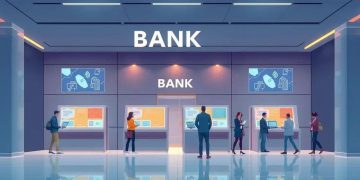Digital banking trends 2025: what to expect

Digital banking trends for 2025 highlight the importance of mobile payments, enhanced cybersecurity, and improved customer experiences through personalized services and innovative technologies.
Digital banking trends 2025 are set to reshape how we interact with our finances. As we look ahead, exciting innovations promise to enhance convenience and security. Have you ever wondered how these trends can impact your daily banking experience?
Emerging technologies in digital banking
Emerging technologies are revolutionizing the landscape of digital banking. It’s exciting to see how these innovations are reshaping our financial experiences. The future of banking will be more efficient and user-friendly, thanks to advancements that cater to customer needs.
Key Innovations to Watch
Many technologies are gaining traction in digital banking. One of the most significant is artificial intelligence, which enhances customer service through chatbots and personalized recommendations. Blockchain is also making its mark by improving security and transparency in transactions.
- Artificial Intelligence: Automating services and improving user interactions.
- Blockchain Technology: Offering secure transaction methods and creating trust.
- Biometric Authentication: Enhancing security through fingerprint and facial recognition.
- Robotic Process Automation: Streamlining admin tasks for greater efficiency.
In addition to these technologies, the rise of cloud computing offers banks the ability to store vast amounts of data securely while improving accessibility. Customers can expect a seamless experience when managing their finances online. With the advent of open banking, customers will have more control over their financial information, opening the door to new services and solutions tailored to their needs.
Overall, as digital banking continues to evolve, customers will benefit from increased convenience and security. The banking sector must adapt quickly to these innovations, ensuring they meet the demands of today’s tech-savvy consumers.
The rise of mobile payments and wallets

The rise of mobile payments and wallets is changing how we conduct transactions every day. With just a few taps on our smartphones, it’s easier than ever to pay for goods and services. This convenience is attracting more users to digital banking platforms.
Benefits of Mobile Payments
There are several benefits that come with using mobile payment options. First, they provide a higher level of convenience, allowing users to make payments anywhere and anytime. Secondly, mobile wallets often enhance security through advanced encryption methods.
- Speed: Quick and efficient checkouts reduce waiting time.
- Security: Biometric authentication adds a layer of protection.
- Rewards: Many mobile wallets offer cashback or points for transactions.
- Integration: Mobile payments can link with various apps for seamless management.
Transitioning to mobile payments also encourages financial inclusivity. Many people in underbanked regions can access these digital wallets without needing a traditional bank account. This opens opportunities for more people to engage in the financial system.
As we look to the future, the adoption of mobile payments is expected to grow even faster. More businesses will likely integrate mobile wallet options, catering to a tech-savvy customer base. This shift will make payments smoother, ensuring customers have a delightful shopping experience.
Impact of cybersecurity on banking practices
The impact of cybersecurity on banking practices is increasingly significant as the industry faces growing threats. Today, banks must prioritize the protection of customer data to maintain trust and integrity. As technology evolves, so do the methods used by cybercriminals.
The Importance of Cybersecurity
Investing in strong cybersecurity measures is essential for any financial institution. A single security breach can lead to devastating consequences, including financial loss and reputational damage. As digital banking grows, ensuring security protocols are updated and effective becomes even more critical.
- Data Encryption: Protects sensitive information and transactions.
- Multi-Factor Authentication: Adds an extra layer of security for users logging into their accounts.
- Regular Security Audits: Helps identify potential vulnerabilities in the system.
- Employee Training: Ensures staff are aware of security practices and phishing threats.
Cybersecurity doesn’t just protect banks; it also safeguards the customers who trust them with their personal and financial information. With rising cyber threats, customers are becoming more aware of security practices. They expect banks to take proactive measures.
As financial institutions adopt advanced technologies, they must also integrate robust security frameworks. This creates a balance between innovation and safety. Building customer confidence in digital banking relies heavily on how well banks can implement security measures that protect their interests.
Customer experience enhancements in banking

Customer experience enhancements in banking are crucial as competition increases. Banks are now focused on making their services more user-friendly and engaging. This shift is driven by the desire to meet the growing expectations of tech-savvy customers.
Key Features Improving Customer Experience
Several innovations are enhancing the way customers interact with their banks. Mobile banking apps have become essential, allowing users to access their accounts and conduct transactions anytime, anywhere. This level of convenience is a game-changer in banking.
- Personalized Services: Banks are using data analytics to offer customized solutions based on individual needs.
- User-Friendly Interfaces: Simplified app designs improve accessibility for all age groups.
- 24/7 Customer Support: Chatbots and live support enhance service availability, providing immediate assistance.
- Feedback Mechanisms: Banks are encouraging customer feedback to continuously improve their services.
Moreover, banks are prioritizing seamless omnichannel experiences. This means customers can move between online platforms, mobile apps, and in-branch services without disruption. As a result, clients feel more connected to their financial institutions.
Enhancements in security measures also play a role in customer satisfaction. Customers are more likely to engage with a bank they trust to protect their information. As technology evolves, providing a safe banking environment is essential for retaining customers and attracting new ones.
FAQ – Frequently Asked Questions about Digital Banking Trends
What are the main benefits of mobile banking?
Mobile banking offers convenience, allowing users to access their accounts and conduct transactions anytime, anywhere.
How does cybersecurity affect banking?
Cybersecurity is crucial for protecting customer data and maintaining trust, especially as banks implement new technologies.
What technologies are enhancing customer experience in banking?
Technologies like AI for personalized services, along with user-friendly mobile apps, are significantly improving customer experience.
Why is feedback important for banks?
Feedback helps banks identify areas for improvement and ensures they are meeting the needs and expectations of their customers.





